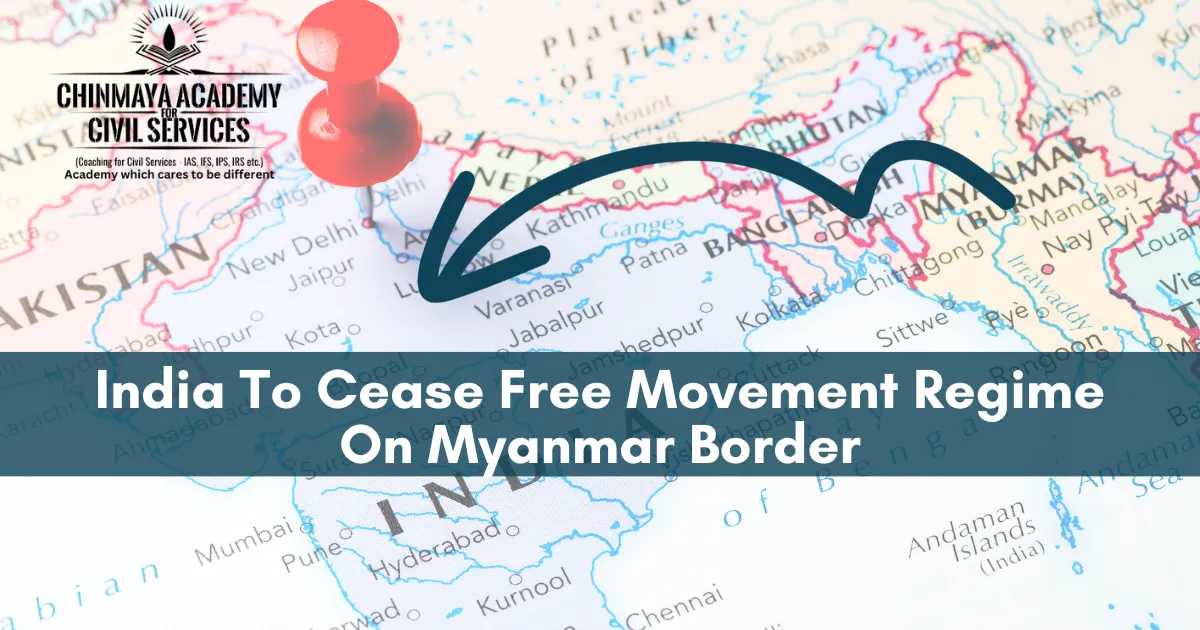
The Union government is prepared to do away with the Free Movement Regime (FMR) along the border with Myanmar.
 The official stated that residents of border regions who may travel to India will soon require visas.
The official stated that residents of border regions who may travel to India will soon require visas.- The arrangement was made in the 1970s because of the unfenced border between India and Myanmar and the close family and ethnic ties that exist between the two countries.
- The most recent revision was made in 2016.
- According to the official, a tender will be released in the coming days and about 300 km of the border will be fenced.
- Using drones, a survey of the border regions has been finished.
Indian-Myanmar Bilateral relationship
The historical factors in the Indian-Myanmar relationship are complex and varied, spanning centuries and leaving a lasting impact on the current dynamic.
Shared Cultural and Religious Ties:
- Ancient Links: Historical exchanges date back to antiquity, with Buddhism playing a pivotal role. Theravada Buddhism, heavily influenced by India, became a cornerstone of Burmese society and culture.
- Ethnic Overlap: Myanmar has a sizable population of Indian origin, estimated at around 2.5 million, further strengthening cultural and familial connections.
- Shared Script: The Burmese script is derived from the Indian Grantha script, reflecting deep cultural exchange.
Colonial Period and Independence:
- British Connection: Myanmar (formerly Burma) was briefly a province of British India until 1937, creating administrative and political links.
- Support for Independence: India actively supported Myanmar’s independence struggle against British rule.
- Treaty of Friendship (1951): Following independence, both countries signed a treaty solidifying close ties.
Political Upheavals and Shifting Dynamics:
- Ne Win’s Regime (1962-1988): Nationalization policies led to the expulsion of thousands of Indian origin people, straining relations.
- 1988 Pro-Democracy Uprising: India’s vocal condemnation of the military’s brutal crackdown caused a temporary freeze in ties.
- India’s Look East Policy (1991): Renewed engagement with Myanmar, focusing on economic and developmental cooperation.
Contemporary Realities:
- Political Divergence: While India is a vibrant democracy, Myanmar has faced military rule and internal conflict, impacting their engagement.
- Strategic Imperatives for India: Myanmar shares a 1600 km border with India, plays a role in India’s “Look East” policy, and serves as a counterweight to China’s influence in the region.
Contemporary Challenges and Cooperation:
- Internal Conflict in Myanmar: India faces the delicate balance of addressing security concerns related to insurgencies near the border while promoting peace and stability in Myanmar.
- Chinese Influence: Myanmar’s increasing economic dependence on China presents geopolitical challenges for India.
- Human Rights Concerns: Myanmar’s military crackdown on pro-democracy protests and Rohingya crisis raise concerns that complicate India’s engagement.
- Chinese Influence: The growing economic and political influence of China in Myanmar presents strategic challenges for India.
- Domestic Politics: Political developments in both countries can impact the trajectory of the relationship.
- Economic and Infrastructure Development: India is actively involved in infrastructure projects within Myanmar, aimed at improving connectivity, trade, and overall development.
- Kaladan Multimodal Transit Transport Project (KMTTP)
- India-Myanmar-Thailand Trilateral Highway (IMT Highway)
- Thathay Chaung Hydropower Project (TCHP)
- Development Projects under RSDP (Rural Roads Scheme Project)
- Upgradation of Tamu-Kalemyo-Kalewa road
- Construction of pre-fabricated houses in Rakhine State
- Capacity Building Initiatives
India and Myanmar are both active members of several international organizations, reflecting their engagement with the global community and their pursuit of common interests. Here’s a look at some key memberships:
Regional Organizations
- Association of Southeast Asian Nations (ASEAN)
- Bay of Bengal Initiative for Multi-Sectoral Technical and Economic Cooperation (BIMSTEC)
- South Asian Association for Regional Cooperation (SAARC)
- Mekong-Ganga Cooperation (MGC)
Global Organizations:
- United Nations (UN)
- World Trade Organization (WTO)
- International Monetary Fund (IMF)
Other Organizations:
- Asia Cooperation Dialogue (ACD)
- Colombo Plan
- Both India and Myanmar are members of the Colombo Plan, which provides technical assistance and training programs for developing countries.
Agreements between India and Myanmar
Political and Diplomatic Agreements:
- Treaty of Friendship (1951): This foundational treaty established amicable relations and cooperation between the two countries.
- Memorandum of Understanding (MoU) on Defence Cooperation (2015): This agreement strengthened cooperation in military training, intelligence sharing, and maritime security.
- Border Management Agreement (1993): This agreement facilitated peaceful border management and collaboration on security issues.
Economic and Trade Agreements:
- Bilateral Investment Promotion Agreement (BIPA) (2008): This agreement encourages and protects investments in each other’s economies.
- Double Taxation Avoidance Agreement (DTAA) (2008): This agreement prevents double taxation on income earned in one country by residents of the other.
- India-ASEAN Trade in Goods Agreement (2009): This agreement applies to bilateral trade between India and Myanmar as part of the broader ASEAN framework.
- Border Trade Agreement (1994): This agreement established and facilitated trade through designated border points.
Development and Cooperation Agreements:
- MoU on Development Cooperation (2012): This agreement provides a framework for India’s assistance to Myanmar in various developmental projects.
- MoU on Science and Technology Cooperation (2019): This agreement promotes academic exchanges, joint research projects, and technology transfer.
- Project Agreement for Construction of a Modern Integrated Check post at Tamu (2022): This agreement signifies India’s involvement in improving border infrastructure and facilitating efficient trade flow.
Cultural and Educational Agreements:
- MoU on Cultural Cooperation (2004): This agreement encourages cultural exchange through artistic collaboration, festivals, and scholarships.
- Indian Council for Cultural Affairs (ICCR) Scholarships: India offers scholarships to Myanmar students for higher education in various fields.
These are just some examples, and the list of agreements between India and Myanmar is extensive. These agreements reflect the diverse areas of their collaboration and their commitment to strengthening their bilateral relationship.
 Chinmaya IAS Academy – Current Affairs Chinmaya IAS Academy – Current Affairs
Chinmaya IAS Academy – Current Affairs Chinmaya IAS Academy – Current Affairs
